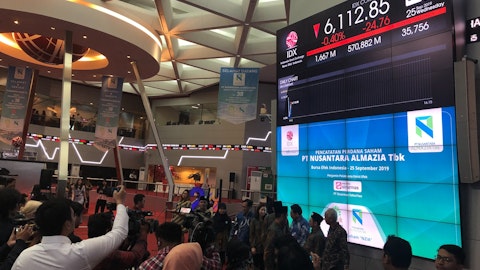RLI Corp. (NYSE:RLI) Q1 2023 Earnings Call Transcript April 20, 2023
RLI Corp. beats earnings expectations. Reported EPS is $1.63, expectations were $1.22.
Operator Good morning and welcome to the RLI Corp. First Quarter Earnings Teleconference. After management’s prepared remarks, we will open the conference up for questions and answers.Before we get started, let me remind everyone that through the course of the teleconference, RLI management may make comments that reflect their intentions, beliefs and expectations for the future. As always, these forward-looking statements are subject to certain factors and uncertainties which could cause actual results to differ materially. Please refer to the risk factors described in the company’s various SEC filings, including the annual report on Form 10-K as supplemented in Forms 10-Q, all of which should be reviewed carefully. The company has filed a Form 8-K with the Securities and Exchange Commission that contains the press release announcing third quarter results.During the call, RLI management may refer to operating earnings and earnings per share from operations which are non-GAAP measures of financial results.
RLI’s operating earnings and earnings per share from operations consist of net earnings after the elimination of after-tax realized gains or losses and after-tax unrealized gains or losses on equity securities. Additionally, equity and earnings of Maui Jim and the related taxes are excluded from the operating earnings and operating EPS for 2022 due to the sale of RLI’s investment in the third quarter of 2022. We RLI’s management believes these measures are useful in gauging core operating performances across reporting periods but may not be comparable to other companies’ definitions of operating earnings. The Form 8-K contains a reconciliation between operating earnings and net earnings. The Form 8-K and press release are available at the company’s website at www.rlicorp.com.I will now turn the conference over to RLI, Chief Investment Officer and Treasurer, Mr. Aaron Diefenthaler.
Please go ahead.Aaron Diefenthaler Thank you, Megan. Good morning and welcome to RLI’s first quarter earnings call for 2023. We — joining us today are Craig Kliethermes, President and CEO; Jen Klobnak, Chief Operating Officer; and Todd Bryant, Chief Financial Officer. As usual, Todd will lead off with a summary of our financial performance in the quarter. Craig and Jen will offer detail on current market conditions related to our product portfolio. We will then take your questions and Craig will close with some final thoughts.Todd?Todd Bryant Thanks, Aaron and good morning, everyone. Yesterday, we reported first quarter operating earnings of $1.63 per share. The quarter’s results reflect strong underwriting performance and continued growth in investment income.
All in, we posted a combined ratio of 77.9% for the quarter and experienced continued top line growth which was up 16% as property and surety led the way. Investment income advanced 51% as we realized elevated income on improved reinvestment rates and a larger invested asset base. Operating cash flow was $69 million, up nicely for the quarter and is supportive of asset growth. Realized gains were $15 million in the quarter. The majority of these gains were from a payout of the working capital escrow from the Maui Jim sale and represents substantially all of the escrowed amounts from this transaction.Also in the quarter, the equity portfolio posted $15 million of unrealized gains. As mentioned on numerous occasions, large movements in equity prices between periods can have a significant impact on net earnings which you can again see in the comparative results this quarter.

From an underwriting income perspective, the quarter’s combined ratio was 77.9% and was in line with last year’s results. Our loss ratio declined 2 points as underlying results improved for both property and casualty. While storm losses added 4 points to the Property segment’s loss ratio versus 3 points last year, attritional losses remained low and were spread across a much higher revenue base. For casualty, the underlying loss ratio improved by 0.5 point due largely to mix shifts as initial current accident year loss ratios are not materially different from a year ago.From a prior year’s reserves perspective, all 3 segments benefited from favorable development. Casualty posted $36 million of favorable loss emergence across the majority of product lines and over multiple accident years.
Property experienced $13 million in favorable development as marine, E&S and admitted property lines posted loss reductions. For surety, favorable reserve development was $3 million, modestly below last year’s level which explains the majority of the increase in the segment’s loss ratio between periods. Our approach to reserving remains the same and the quarter’s results are reflective of a consistent process of evaluating loss reserve studies, one quarter in arrears, and considering actual versus expected losses for the current period.Moving to expenses. Compared to last year, our quarterly expense ratio increased 2 points to 40.7%. Elevated incentive-related amounts account for nearly 1.5 points of this increase. Most notably, amounts influenced by operating return on equity and growth from book value were up significantly compared to the first quarter of last year.
In addition, we have increased investments in both our people and technology to support growth, improve customer experience and to drive efficiencies. Despite some submarket volatility, quarterly investment returns were positive at 2.8%, with both stocks and bonds contributing to comprehensive earnings of $137 million. Although the retreat in bond yields was significant in March, we still found accretive opportunities in fixed income and purchase yields averaged more than 4.5% for the quarter. There has been a little change to our investment strategy over the last year with a focus on putting meaningful amounts of cash flow to work in high-quality bonds.Incorporating comprehensive earnings and adjusting for dividends, book value per share increased 12% in the quarter to $28.62 per share.
Away from the traditional investment portfolio, investee earnings were down but that comparison is largely influenced by our sale of Maui Jim which contributed over $6 million to last year’s results. As noted last year and highlighted in the press release for comparative purposes, we have excluded earnings from Maui Jim in our calculation of operating earnings for 2022. All in all, a very good operating quarter and strong start to the year.And with that, I’ll turn the call over to Craig.Craig Kliethermes Thank you, Todd and Aaron and good morning, everyone. I’m very pleased with our start to 2023 with continued double-digit top line growth and a sub-80 combined ratio, very similar to last year. Our continued ability to deliver is a testament to the quality of our people, the diversity of our product portfolio and our disciplined underwriting culture.
These attributes allow our associate owners to make the best long-term decisions for the benefit of our customers and shareholders. RLI believes in the marshmallow test. We have the resolve to be a stable market with a consistent risk appetite through all market cycles. There remains a fair amount of dislocation, economic uncertainty and capital shortfalls in much of the industry, particularly in wheels and catastrophe exposed lines of businesses.Rates continue to be up with even greater momentum for wind and earthquake exposures. We are finding that although competition is tougher in many of our liability and surety businesses, there seems to be some reluctance for the markets to behave too irrationally as reinsurers are doing a better job passing along their costs to the primary market and creating general concern over the availability and price tag of their capacity.
We appreciate smart competitors and discerning capacity. We prefer to compete in markets where measured risk-taking and discipline are more pervasive. We think our portfolio is very healthy and our talented underwriters are poised to grow where rates adequately cover the risk.I’m going to turn it over to Jen who can provide a lot more color on our portfolio and talk about where we’re seeing the best opportunities. Jen?Jen Klobnak Thank you, Craig. The Property segment once again drove the top line results and produced a 68% combined ratio for the quarter. Rate change for the segment was positive 24%, while claim activity was fairly quiet. The headline continues to be in the Southeast property market. Hurricane rates were up 47% for the quarter which continues a string of quarterly double-digit rate increases going back to the fourth quarter of 2019.
With the rate a primary driver of premiums, exposure growth has been limited. We have not seen new capacity in the Florida market in quite some time and competitors continue to manage their events closely which creates space for multiple carriers to participate on a risk, including RLI.Submission costs have remained strong as property risk shifts from the admitted to the E&S market. At the end of the day, we are in the claim resolution business and are happy to report that 2/3 of our hurricane Ian claims are now closed. Our claim examiners continue to visit our insurers in Florida to reinspect location and address any issues. E&S property grabbed the headlines again, Marine and our Hawaii homeowners folks are quietly thriving as well. We successfully grew Marine by 16% and Hawaii by 18% by being responsive to our producers and providing superior service and tailored solutions.
Marine continues to deliver steady rate increases totaling 7% for the quarter. With our solid results, Marine is proving to be a go-to partner in a dynamic market. Our Hawaii Homeowners product experienced some losses during the quarter but continues to perform well overall. We believe our property segment is healthy and we expect to see continued growth opportunities going forward.The Casualty segment’s premium grew 1%, while it produced an 83 combined ratio. Growth was flat as we continue to demonstrate underwriting disciplines in several areas of this portfolio. Effective January 1, we exited the energy excess liability market and reduced our participation on Prime’s quota share reinsurance treaty. The combined impact of these changes was about a $10 million decrease to premium in the first quarter.
Producing consistent profitable results stems from a willingness to pare back underperforming portions of our portfolio when needed or rebalance products to better align with our appetite. Conversely, disrupted markets are ripe with opportunities to grow, as demonstrated by personal umbrella, where competitors are changing their risk appetite or leading the market. Here, we have refreshed our policy form, target regular rate increases and work with our producer partners to manage growth by region. PUP premium was up 23% and we are monitoring this growth closely.Steady growth was also achieved by our professional services group which focuses on architects and engineers professional liability and package coverages as well as small commercial packages for contractors.
This group ramped up marketing efforts in the first quarter and produced 8% growth in gross premiums written. Our executive products group is in a tougher market, where the public D&O sector remains under pressure. One of our brokers said that 20 new competitors have entered this market in the last 18 months. We believe these new entrants are late to the party and are providing brokers with more mouths to feed. Our EPG premium was down 14% in the quarter. We experienced 5% rate decreases but we’re able to achieve growth outside of public D&O. Finally, we saw delays in the start of private construction projects and our E&S casualty primary and excess liability business in the first quarter. Project owners are having to exert more efforts to obtain financing, permits and needed project supplies.
These issues vary by geographic region, with the Northeast being the most impacted. New competition who generally provide broader coverage has entered the space as well.Premium for the group was down 9%, although we were able to obtain 5% rate increases on the primary business and 6% on the asset. One quarter is too early to call it a trend but we are monitoring construction industry information closely and continuing to work with our producers to monitor submission flow. The Surety segment grew premium by 14% and produced a 77 combined ratio. While building materials inflation continues to support growth in contract surety, we are also winning new accounts in our contract and commercial surety businesses through increased marketing efforts and a focus on excellent service.
While we are off to a solid start for 2023, we are watching economic conditions and the financial health of our principals closely and have gotten off several accounts whose financial results deteriorated. With robust competition in the market, we believe growth opportunities within this segment may be more moderate in the year ahead.And now, I’ll turn the call back over to Craig.Craig Kliethermes Thanks, Jen. A very good start to the year. It’s giving us good momentum going into the more catastrophe-exposed spring and fall quarters. We will continue to remain vigilant around opportunities and risks as we navigate the uncertainty and disruptions in the market. We can be patient and when required, we could be patient when required but like the boxer Archie Moore, we also have the proven ability to adapt and counterpunch with speed and skill.
The speed is derived from our consistent underwriting approach and strong balance sheet which gives us the confidence to execute amid market uncertainty. The skill comes from our associates narrow and deep knowledge that bring added value to our customer and better risk selection. RLI will continue to invest in its people, customer relationships and technology to grow underwriting profits over time.I want to thank all of our RLI associate owners for the results they generated this quarter. Keep up the great work. And RLI, it is okay to be different because different works.I’ll now turn the call back over to the operator for any questions.
See also 35 Most Beautiful Places In The World and 8 Best Insider Trading Websites in 2023.
Question-and-Answer Session
Operator: Thank you. The question-and-answer session will begin at this time [Operator Instructions] Our first question comes from Greg Peters.Unidentified Analyst This is Sid on for Greg.
Just wanted to talk about the Casualty segment, Jen, you provided great detail there on the growth. And we’re just trying to get a sense, I guess, on where we are in the timing with the previously exited lines and then it sounds like there’s additional lines that have been exited. So just, I guess, trying to set our outlook for growth in the Casualty segment.Jen Klobnak Yes. Thanks for the question. So in terms of the excess energy liability business, that’s not a bond that was a liability product that we exited last year. We still write primary business. So we have effective January 1. I think last year, we wrote between $15 million and $20 million of excess liability premium. So about $5 million of that was in the first quarter roughly. And so you’ll see the rest of that throughout the year.
It did slow down towards the end of last year, so that’s probably weighted towards the first 3 quarters of the year. And another part was just our prime reinsurance that we assume. And so we took half of our participation that we used to do in 2022. So that impacted our premium as well. And we would see that throughout the year, it’s more evenly spread.Operator Thank you. Our next question comes from the line Meyer Shields.Meyer Shields Great. I’m sorry, I’m coming through? Okay. Fantastic. Sorry about that. Jen, you mentioned 20 carriers entering the space. And up until now, we’ve heard that their focus has been fairly limited to public company D&O. And I’m wondering, does that match what you’re seeing? Or are they now looking for other lines of business to attack or to soften?Jen Klobnak Yes.
Thanks for the question, Meyer. I think we are seeing them mostly participate in public D&O. So the 20 new competitors are a mix of carriers and a lot of MGAs. Some of those folks also play in other parts of that general space, such as the Reps and warranty business which we’re no longer in. They haven’t been focused as much on the private yet but we’re ready for competition to come anywhere so. But for now, you’re right, it’s been mostly focused on the public D&O.Meyer Shields Okay, that’s helpful. And I know we talked about this in the past but how are you thinking about loss trends in property as that book grows? And I’m wondering specifically, is there an annual increase that we should expect from climate change in addition to the impact of inflation?Jen Klobnak Well, I would say that in terms of climate change, we have seen some increased activity in the last few years which we’ve been adjusting for over time through rate increases and form changes.
We don’t provide a lot of coverage for some of the perils that are connected to climate change, such as flood. So we don’t have a lot of that in our portfolio. The Wildfire would be another example where we do have at risk but we are very aware of WildFire. So we try to really underwrite to that risk and charge for that. I would say, now I’ve forgotten your question.Meyer Shields How about the ban of loss trend affected with that?Jen Klobnak Yes, thank you. So in terms of loss trend, this is impossible to measure. We have put in some loads for various perils and other factors within our benchmark pricing tool but there’s no precision or a lot of calculations around that because, as you know, that’s a topic that is evolving. So I’m going to give you a large kind of a high-level answer on that one.Craig Kliethermes The only thing I’d add there is we do spend a lot of time on the front end, making sure we get the correct valuations there’s been an increase that we’ve always had a focus on that but really an increased effort recently because of material costs and things like that.
So we’ve kind of reevaluated our entire portfolio at renewal and look at accounts have conversations with our insurers and our brokers about making sure we get the right valuations on a property.Operator Thank you. Our next question comes from Mark Dwelle.Mark Dwelle I’m going to kind of build on what Meyer just asked about. So with all the additional property that you’ve been writing, is it safe to say that the Southeast now would be your kind of peak risk zone for property exposures? Or would it still be, I don’t know, Hawaii or California quake or whatever it might have been previously?Jen Klobnak Well, that’s a good question. It depends on how you measure it. As you know, when it comes to catastrophe risk, there’s a lot of ways to measure it, whether you’re using a model or using exposed limits.





